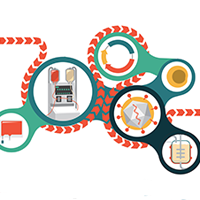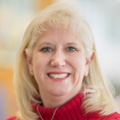Optimizing the Cell Collection Network to Support the Commercialization of Cell & Gene Therapies
Cell Gene Therapy Insights 2018; 4(3), 197-206.
10.18609/cgti.2018.021
A key part of the supply chain for CGTx is the collection of donor or patient material. What are some of the challenges when the starting material for these CGTx products is a human cellular product?
AH: Obviously one of the biggest challenges is that every human is different so the starting material will vary based upon human and health characteristics. Things like cell counts or tolerance of procedures can vary between donors, so it’s not necessarily apples to apples for every collection. Even when specifications of a collection are identical, in terms of volume collected or time on the machine, it doesn’t necessarily mean that you’re going to end up with a uniform product between two donors. Variability is a major challenge in this industry in terms of having uniform and consistent starting material for manufacture.
SH: Amy’s comment sums up the collection process. I’ll add that some of the instruments are fairly self-operational, which helps remove some of the collection variability between centers.
KK: Another point to consider is that every collection center will have its own standard operating procedures for collection, which can add some variability and may impact the collection. It is key that collection centers have quality programs, which helps to monitor what is being collected, and whether or not they are obtaining sufficient and efficient collections. The center’s quality program helps to determine and understand the center’s collection capability.
What approaches does your center take to mitigate, or at best minimize, these challenges to collecting adequate and consistent starting material?
KK: Minimizing variability among a variety of centers can be difficult. Consistency in training, standard operating procedures, and machinery used, as well as maintaining clinical competencies can all increase consistency. It is also important to maintain paper trails or some type of documentation for tracking and tracing variabilities. With documentation we can go back and look to see what may have happened differently, what has worked well and what has not to decide what may need to be tweaked. These guidelines can help with variability within one facility, but when trying to keep collections consistent among multiple centers, it can be a challenge.
SH: Giving the nurses specific criteria that they can adhere to will help to mitigate some of these collection variabilities. Work aids would help to keep consistency and prepare for collections that follow different protocols. That’s the best thing we can do to minimize inconsistencies.
AH: There are only so many things you can standardize and control. Obviously you can’t control the human being, who is the source of your starting material, but when it comes to the equipment, protocols and standard operating procedures, we can control most of those things. With standard operating procedures we can come pretty close to consistency across centers, but every institution is going to have its own subtle differences that might make an SOP read differently at one center as opposed to another. It’s critically important to maintain control of key manufacturing steps, decide what conditions from center A to center B can be exactly the same, and to gather actionable data during collections to identify areas for improvement. To achieve this, it’s necessary to collect information from center to center to decide on particular aspects of the procedure that can be standardized and lead to better outcomes.
What capabilities can the apheresis centers offer to tie product quality to outcomes, which will be critical to understanding why some of the therapies work or do not work?
KK: Apheresis centers offer expertise in collection, a skill not held by every nurse or physician. These centers maintain documentation about the donor characteristics, controls that were used and the procedure used to collect, so we can track and trace what happens to the product as it moves along in the manufacturing process. Tracking and traceability become critical in understanding why a product either worked or did not. Understanding the baseline donor characteristics also helps to determine if the timing was right to collect cells from a particular individual and possibly explain why cells did not expand or work as expected.
SH: I certainly agree with Kim. Entering specifics into CIBMTR (Center for International Blood and Marrow Transplant Research) outcomes database for the cellular therapies would be helpful. We need to get these results to a database where they can cross-reference everything.
AH: One of the things that may not be considered by the cell and gene therapy industry is that apheresis centers have access to a lot of different information about the human characteristics that go into a particular product. This information could shed light on why a particular donor just didn’t work out, or what made another person a super donor. Also, apheresis centers have specially trained nurses, and apheresis is kind of an art. Yes, the machine does the physical collection, but the apheresis nurse and staff understand the process and places where there is variability in the process very well. They know which indicators could be important to help determine the quality of a product or why something worked or didn’t work. The expertise in the apheresis field generates a lot of information that can be taken into consideration when trying to decide what is feasible or standardizable, and what is not for a given cell therapy.
How is the collection process different for a sick patient, such as a cancer patient undergoing CAR-T therapy, versus a healthy donor?
SH: When collecting from a sick patient versus a healthy one, the process would be dependent on the specific cell therapy you’re collecting for since it’s all about timing. The patient may need to be an inpatient, which would affect scheduling. A healthy donor, on the other hand, might have some more leeway in scheduling and might not have to come in as urgently. It depends on what the cell therapy is for. Also, when performing a collection, nurses may be taken off the floor, which leaves other nurses in charge of more patients in the apheresis center, which could be another concern.
KK: Another point to consider about collecting from sick patients is the difference between working with adults versus pediatric patients, as this can impact the location and timing of collection. Many adult, and some pediatric patient collections are performed on an outpatient basis, whereas it may be preferable that collections for some children, like those under 20 kg at my institution, be performed inpatient, such as the intensive care unit. Another issue when collecting from a sick patient is that the cell dose may be very low compared to a healthy donor, so more volume would need to be collected from the sick patient.
In addition, sick patients may need a central venous catheter and may not have one at the time of the collection. So, it would need to be decided if the patient should have a permanent or temporary catheter. All together it can be a bit of a challenge when also considering the rest of the apheresis schedule and making sure everything is choreographed correctly.
Would your center consider allowing an autologous patient to have their cell collection performed at an institution other than yours?
SH: Collections for autologous patients require qualification from the particular pharmaceutical company we’re working with and, unless there is another qualified center, I don’t think it would be allowed for cells to be collected from another institution. We would potentially allow the collection from another facility if it was from our own in-house processing.
KK: Our center would prefer to perform collections on our own patients. We have an accredited apheresis center and our clinical and apheresis providers and staff communicate to provide the best care possible to our donors/patients.
AH: There may be some centers that would allow their patients to be collected elsewhere, which could be another potential challenge for the industry in terms of standardization. However, the other facility would also need to be qualified and accredited. Collection location would depend on whether the product would need to go back to that patient’s home institution, or if it goes elsewhere. But there are also centers, especially in pediatrics, where collecting anywhere else would not be allowed. The patient may need to be home and under their treating physician’s care. The industry needs to consider that these patients are under the care of the physician, and it’s that physician’s right to determine where their patient is going to be able to go for their collection. The doctor could order the collection at their center, or maybe would allow it off-site, but that center would also need to be qualified for that particular product and cell therapy company.
What challenges are apheresis centers facing with the expanding number of cell therapies in development and approaching commercialization?
SH: Getting a good handle on the many different protocols and departments participating in them has been a challenge. All of them want apheresis and they all have specific timeframes, and on top of this, we’re still trying to serve our regular therapeutic and transplant patients.
KK: The increase in the number of protocols has become an issue and affects scheduling. Our apheresis center does not only service our transplant and cell therapy program. They support a big hospital, servicing our hematology and solid organ transplant patients, performing red cell and plasma exchanges. So, scheduling, staffing, space and training all become issues. One of the biggest challenges is how to convince administration to be proactive in expanding the number of nurses, machines and whatever is needed to accommodate an expanding cellular therapy program. There are continually more research protocols coming out, more commercial products that are available and more requests from companies asking institutions to participate to attain FDA-approval for their products. Scheduling can be a challenge as there is a limitation with the number of trained apheresis nurses and who may be called in during the night, which may impact the schedule the following day. As we enter budget season for the next fiscal year, how do we convince institutions to be proactive to help our apheresis centers and in the end help our patients by being able to provide front-line therapies? Developing metrics on the number or variety of procedures that need to be performed to support expanding apheresis resources will be crucial.
AH: It’s also a challenge to expand apheresis services when we can only speculate what future needs might be, and we have to do that in the midst of a rapidly changing cell therapy environment. We are experiencing scheduling challenges related to availability of nurses, apheresis machines and cell lab staff already. Centers are doing what they can to catch up to the demand for apheresis services; however, it’s difficult enough for a center to meet current apheresis needs, and even more challenging to prepare for anticipated future capacity.
With such a large and growing network of apheresis centers, what has been your approach, Amy, to standardize global/multi-site apheresis?
AH: Be The Match BioTherapies is leveraging our network to help our centers work within the cellular therapy space. We learn about our centers to understand what their capabilities are and then do everything we can to provide opportunities for standardization and assistance, such as providing SOP templates, job aids and most importantly, training. We develop training based on a particular client protocol and are able to deliver the training on-site as well as via WebEx. As was mentioned earlier, there is a lot going on at apheresis centers and some cellular therapy collections, especially those for rare and ultra-rare conditions, both in the clinical and commercial setting, may not occur very often.
To support this work, we stay in close communication with the collection centers so that, if for instance, they haven’t collected for a specific protocol in 6 months, we are able to reach out to them ahead of time and give them some quick refresher material. We supply job aids that illustrate key manufacturing, GMP, GTP and FDA-compliance protocols that are needed in order to perform the collection appropriately. It’s important to realize that cell therapy is a global market now, and so it’s necessary to reach out to the appropriate regulatory bodies to ask what differences there are in collections in different regions or between autologous versus allogeneic collections.
We try to be very aware of what’s happening at each of the centers so that we can be available to provide materials and resources needed to collect product. We aim not only for standardization across centers, but also for each to be compliant so that each product can be further manufactured. This is especially important in the autologous setting, because for some patients, it may be their one and only shot at being able to get a product to the manufacturer. Providing support to ensure that a product is successful and able to be delivered back home for that patient’s transfusion is what we strive to do by providing these services to the centers.
What steps are taken to ensure regulatory compliance and the use of industry best practices at collection centers?
KK: One potential opportunity for the industry is to utilize the CIBMTR to collect data. The CIBMTR has developed data collection forms for cellular therapy products, which will be really helpful in answering relevant questions on best practices by aggregating the data. Since immune effector cells have started to be infused through transplant and cellular therapy programs, centers are achieving accreditation for immune effector cells. To achieve accreditation in this field, programs are required to analyze their outcomes for each type of cellular therapy product. Combining individual program data with other centers in aggregate will help determine best practices we can apply to the industry.
SH: The QA department within each facility verifies compliance within the regulatory mandates. Also, industry meetings, such as the AABB or ISCT, are a great spot to learn of new best practices or changes in regulations. The FDA also sends out emails with updates on what has changed. Overall, staying on top of all of the guidance has been a challenge.
Describe your center’s efforts to adapt processes and procedures in order to maintain compliance with multiple clinical protocols.
SH: If there were a standardized way of doing things, it would help us to be more efficient. Right now, there are two different sites we need to log into depending on what product we’re collecting for. There are also different procedures for collections that we have to work with and it’s been a challenge to maintain competency among enough staff since they don’t perform these specialized collections every day. We try to adapt to it, but everyone has a different way of doing things, which makes it difficult to keep up.
KK: We’ve seen that companies are approaching the topic of apheresis during the clinical phases of their products, when it would be helpful to have representatives from apheresis centers at the table from the beginning, taking part in the planning stages. Apheresis experts are the ones that know the capabilities of the centers and what could be modified to achieve the best results for each product. Open communication and early integration of apheresis groups into the planning process is really important. One center may be working with several different companies, which means using several different websites and databases. It would be helpful, before production begins, to include apheresis experts in early discussions. Applying this concept may help to better standardize the field as well.
Extensive logistics are involved in collecting an apheresis product. As an increase of cellular therapy products are needing to be collected through apheresis centers, conversations between companies and apheresis representatives need to happen before commitments to the patient and cellular therapy production are already made.
AH: There is a bit of a gap in recognition of the role of apheresis centers by the industry. We are all trying to provide the best therapy for a given patient, but the industry needs to consider the capacity and capabilities of apheresis centers, as well as how their protocols affect the staff and scheduling. Including apheresis experts who know the true apheresis environment at the table and involving them early in development to decide on the most feasible and rational protocols is key to providing standards for collecting the best product. It’s a concept that can be underestimated in the industry.
Be The Match BioTherapies has been present at several industry conferences and meetings to make known this gap. We realize the challenges and opportunities that are in front of our apheresis and transplant centers and try to bring their voices to the industry. I think we’ve been relatively successful this year in opening people’s eyes to the fact that there’s an entire part of the manufacturing process that involves human beings, and that introduces some variability. It’s not as easy as manufacturing some hands-off product where following a protocol exactly leads to a perfect product. There is a human factor involved. We have made a significant investment to be visible and to bring that voice to the industry.
Where do you see the biggest opportunities for apheresis centers and Be The Match BioTherapies to support the continued growth of CGTx?
SH: The biggest opportunities are to have apheresis centers more involved at the beginning of cellular therapy process planning, and to work with Be The Match BioTherapies to collect for other centers. It’s been very helpful for us to have Be The Match coordinate our related donors and I can see that arrangement continuing with Be The Match BioTherapies coordinating donors for cellular therapy companies.
KK: A variety of cellular therapy products are coming down the pipeline and that creates a significant opportunity for apheresis centers to participate in the care of patients. As mentioned before, apheresis is a specialized field, and we need to figure out how to keep up with the demand for both transplant and cellular therapy products. It is also critical that apheresis centers are able to stay afloat and expand, which means making sure that reimbursements to the centers are on target. Apheresis nurses will be excited to be part of these new therapies, but it’s important to give them information about if and how the therapies are working so that they know they’re personally impacting patient outcomes.
AH: We need to remember that there are shortages in all areas of nursing, and more shortages to come. So, one of my concerns for sustainability of the field is the ability to attract and retain apheresis nurses. Sharing with the nurses the impact of their work would help. An apheresis nurse may only see a patient once when performing a collection, but might not get a sense of satisfaction or realization that what he or she did in that moment really helped that patient through the process. So, from a nursing perspective, I think we need to do more to support, attract, and retain nursing staff.
Some centers may need support from outside of their organizations to raise awareness that apheresis centers could use additional resources, such as staff and equipment, to meet the needs of patients as the cellular therapy industry grows. Be The Match BioTherapies can help advocate for additional apheresis resources within these organizations.
Affiliation
Amy Hines, Director of Collection Network Management, Be The Match BioTherapies
Kimberly Kasow, Director of the Pediatric Bone Marrow Transplant program, University of North Carolina at Chapel Hill
Sandra Hoffmann, Supervisor of the Cellular Therapy Laboratory, University of Michigan
This work is licensed under a Creative Commons Attribution- NonCommercial – NoDerivatives 4.0 International License.




